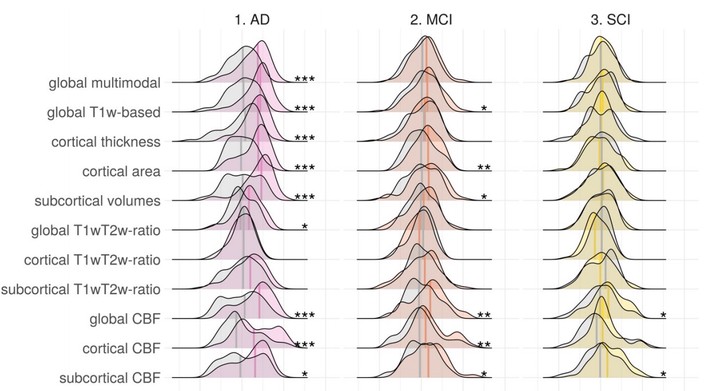Multimodal imaging improves brain age prediction and reveals distinct abnormalities in patients with psychiatric and neurological disorders

Abstract
Background: The deviation between chronological age and age predicted using brain MRI is a putative marker of brain health and disease-related deterioration. Age prediction based on structural MRI data shows high accuracy and sensitivity to common brain disorders. However, brain aging is complex and heterogenous, both in terms of individual differences and the biological processes involved. Here, we implemented a multimodal age prediction approach and tested the predictive value across patients with a range of disorders with distinct etiologies and clinical features. Methods: We implemented a multimodal model to estimate brain age using different combinations of cortical area, thickness and sub-cortical volumes, cortical and subcortical T1/T2-weighted ratios, and cerebral blood flow (CBF) calculated from functional arterial spin labeling (ASL) data. For each of the 11 models we assessed the age prediction accuracy in HC n=761 and compared the resulting brain age gaps (BAGs) between each clinical group and age-matched subsets of HC in patients with Alzheimer9s disease (AD, n=54), mild cognitive impairment (MCI, n=88), subjective cognitive impairment (SCI, n=55), schizophrenia (SZ, n=156), bipolar disorder (BD, n=136), autism spectrum disorder (ASD, n=28). Results: Among the 11 models, we found highest age prediction accuracy in HC when integrating all modalities (mean absolute error=6.5 years). Beyond this global BAG, the area under the curve for the receiver-operating characteristics based on two-group case-control classifications showed strongest effects for AD and ASD in global T1-weighted BAG (T1w-BAG), while MCI, SCI, BD and SZ showed strongest effects in CBF-based BAGs. Conclusions: Combining multiple MRI modalities improves brain age prediction and reveals distinct deviations in patients with psychiatric and neurological disorders. The multimodal BAG was most accurate in predicting age in HC, while group differences between patients and controls were often larger for BAGs based on single modalities. These findings demonstrate that multidimensional phenotyping provides a mapping of overlapping and distinct pathophysiology in common disorders of the brain, and specifically suggest metabolic and neurovascular aberrations in SZ and at-risk and early stage dementia.